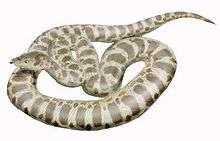Titanoboa
| Titanoboa Temporal range: Paleocene, 60–58 Ma | |
|---|---|
 | |
| Illustration by Nobu Tamura | |
| Scientific classification | |
| Kingdom: | Animalia |
| Phylum: | Chordata |
| Class: | Reptilia |
| Order: | Squamata |
| Suborder: | Serpentes |
| Family: | Boidae |
| Subfamily: | Boinae |
| Genus: | †Titanoboa Head et al., 2009 |
| Species: | †T. cerrejonensis |
| Binomial name | |
| Titanoboa cerrejonensis Head et al., 2009 | |
Titanoboa, /tiˌtɑːnoʊˈboʊə/; meaning "titanic boa,"[1] is an extinct genus of snakes that lived about 60–58 million years ago, during the Paleocene epoch,[2] a 10-million-year period immediately following the Cretaceous-Paleogene extinction event.[3] The only known species is Titanoboa cerrejonensis, the largest snake ever discovered,[2] which supplanted the previous record holder, Gigantophis.
Palaeobiology
.jpg)
While initially thought to have been an apex predator of the Paleocene ecosystem in which it lived, evidence has pointed to the genus being dominantly piscivorous; a trait unique to Titanoboa among all boids.[4] The size of T. cerrejonensis has also provided clues as to the earth's climate during its existence; because snakes are ectothermic, the discovery implies that the tropics, the creature's habitat, must have been warmer than previously thought, averaging about 32 °C (90 °F).[1][2][5][6] The warmer climate of the Earth during the time of T. cerrejonensis allowed cold-blooded snakes to attain much larger sizes than modern snakes.[7] Today, larger ectothermic animals are found in the tropics, where it is hottest, and smaller ones are found farther from the equator.[3]
However, other researchers disagree with the above climate estimate. For example, a 2009 study in the journal Nature applying the mathematical model used in the above study to an ancient lizard fossil from temperate Australia predicts that lizards currently living in tropical areas should be capable of reaching 10–14 m (32.8–45.9 ft), which is obviously not the case.[8] In another critique published in the same journal, Mark Denny, a specialist in biomechanics, noted that the snake was so large and was producing so much metabolic heat that the ambient temperature must have been four to six degrees cooler than the current estimate, or the snake would have overheated.[9]

By comparing the sizes and shapes of its fossilized vertebrae to those of extant snakes, researchers estimated that the largest individuals of T. cerrejonensis found had a total length around 12.8 m (42 ft) and weighed about 1,135 kg (2,500 lb; 1.12 long tons; 1.25 short tons).[1]
Location
In 2009, the fossils of 28 individuals of T. cerrejonensis were found in the Cerrejón Formation of the coal mines of Cerrejón in La Guajira, Colombia.[1][2] Before this discovery, few fossils of Paleocene-epoch vertebrates had been found in ancient tropical environments of South America.[10] The snake was discovered on an expedition by a team of international scientists led by Jonathan Bloch, a University of Florida vertebrate paleontologist, and Carlos Jaramillo, a paleobotanist from the Smithsonian Tropical Research Institute in Panama.[3]
In popular culture
On 22 March 2012, a full-scale-model replica of a 14.6 m (48 ft), 1,135 kg (2,500 lb) Titanoboa was displayed in Grand Central Terminal in New York City. It was a promotion for a TV show on the Smithsonian Channel called Titanoboa: Monster Snake which aired on 1 April 2012.[11][12]
References
- 1 2 3 4 Head, J. J.; Bloch, J. I.; Hastings, A. K.; Bourque, J. R.; Cadena, E. A.; Herrera, F. A.; Polly, P. D.; Jaramillo, C. A. (2009). "Giant boid snake from the paleocene neotropics reveals hotter past equatorial temperatures". Nature. 457 (7230): 715–718. doi:10.1038/nature07671. PMID 19194448.
- 1 2 3 4 Kwok, R. (4 February 2009). "Scientists find world's biggest snake". Nature News. doi:10.1038/news.2009.80.
- 1 2 3 "At 2,500 Pounds And 43 Feet, Prehistoric Snake Is Largest On Record". Science Daily. 4 February 2009. Retrieved 6 February 2009.
- ↑ Head, J.J; Bloch, J. I; Moreno-Bernal, J. (2013). "Cranial Osteology, Body Size, Systematics and Ecology of the giant Paleocene snake Titanoboa cerrejonensis". Vertebrate Paleontology: 140–141.
- ↑ Joyce, C. (5 February 2009). "1-Ton Snakes Once Slithered In The Tropics". NPR. Retrieved 5 February 2009.
- ↑ Shellito, C. J.; Sloan, L. C.; Huber, M. (2003). "Climate model sensitivity to atmospheric CO2 levels in the Early–Middle Paleogene". Palaeogeography, Palaeoclimatology, Palaeoecology. 193: 113. doi:10.1016/S0031-0182(02)00718-6.
- ↑ Makarieva, A. M; Gorshkov, V. G; Li, B.-L. (2005). "Gigantism, temperature and metabolic rate in terrestrial poikilotherms". Proceedings of the Royal Society B. 272 (1578): 2325–2328. doi:10.1098/rspb.2005.3223. PMC 1560189
 . PMID 16191647.
. PMID 16191647. - ↑ Sniderman, J. M. K. (2009). "Biased reptilian palaeothermometer?". Nature. 460 (7255): E1. doi:10.1038/nature08222.
- ↑ Denny, M. W.; Lockwood, B. L.; Somero, G. N. (2009). "Can the giant snake predict palaeoclimate?". Nature. 460 (7255): E3. doi:10.1038/nature08224.
- ↑ Maugh II, T. H. (4 February 2009). "Fossil of 43-foot super snake Titanoboa found in Colombia". Los Angeles Times. Retrieved 4 February 2009.
- ↑ "Titanoboa: Monster Snake". Smithsonian Channel. Retrieved 5 April 2013.
- ↑ "Titanoboa: Monster Snake - History's Deadliest Predators". Youtube. Smithsonian Channel. 21 March 2012. Retrieved 16 October 2016.
External links
| Wikimedia Commons has media related to Titanoboa. |
- A Snake the Size of a Plane: How did prehistoric animals get so big? By Nina Shen Rastogi. 5 February 2009.
- BBC article on Titanoboa
- Titanoboa: Monster Snake at the Internet Movie Database